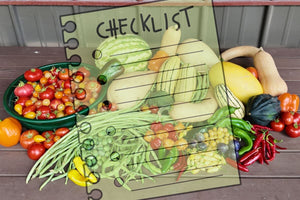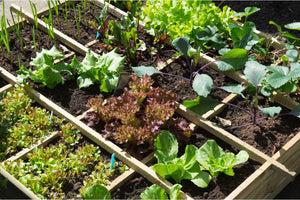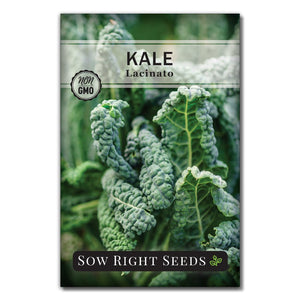How to Grow Kale From Seed For a Nutritious Harvest All Year Round
Leafy greensLooking for a cool weather crop that’s easy to grow and incredibly nutrient dense? Grow Kale. Not only is it one of the healthiest vegetables to eat, but it’s always beautiful in the garden.

Kale seeds can be sown outdoors or started indoors and easily transplanted. Leaves can be harvested from kale plants that continue to grow even into the winter. Follow our easy steps to start growing this hardy green.
Quick Links
When to Plant Kale Seeds
Kale is a cool weather crop that can be directly sown in the garden or transplanted from seed started indoors. The choice to direct sow or start seeds indoors will hinge on how quickly temperatures rise above 75ºF and when you want to harvest kale.
For spring planting, sow kale seeds indoors 6 to 8 weeks before the last spring frost date. Or sow directly outdoors 4 to 6 weeks before the last frost.
Sow seeds 1/4” deep. Plant 2-3 kale seeds per flat and then thin to the one most viable plant.
Transplant kale in a sunny spot with rich, well-drained soil.
For a fall and winter harvest, plant kale seeds directly in the garden.
If spring temperatures move quickly from 60º to 85º and up, you may find growing kale in the fall and winter will give you a longer harvest.

How to Grow Kale Plants
Transplant kale outdoors 2 to 4 weeks before the last frost spring frost.
Kale grows best in loamy soil that drains well. You can use mulch to help retain moisture.
Space kale plants 12 to 18 inches apart.
Kale grows in full sun to partial shade. 3 to 4 hours of direct light is needed daily. Afternoon shade can help the plants stay cool and resist bolting.
When the plants are about 5 inches tall, you can add additional fertilizer and side-dress with compost.
Use floating row covers to keep bugs off. Read our blog on Dealing with Pests and Diseases in the Garden for other pest and disease remedies.
Since kale is a cool-weather plant, it can be rotated in the garden with hot-weather plants. For example, plant kale early in the spring and remove it when summer temperatures get too hot. Then use that space for your hot weather vegetables.
Kale will continue growing in the winter until temperatures drop below 20ºF. For tips on overwintering your vegetable garden, read our blog.
Growing Kale in Pots
Kale can be grown in pots that are about 12 inches deep. Keeping containers moist and well-fertilized is vital. We cover specifics on container gardening in our Planter’s Library.
Harvesting Kale - and keep it growing
Kale will keep growing as long as it doesn’t get too hot or too cold. The tastiest and most tender greens are the younger leaves. You can start picking kale leaves when they are about 5 to 6 inches long. When they get bigger, the leaves are tougher and taste bitter.
Kale plants grow new leaves from the center of the plant. So to harvest kale and keep it growing, pick a few leaves at a time from the outer edges.
Using a knife or scissors will ensure a clean cut without pulling the rest of the plant.
Once leaves are picked, don’t wash them until you are ready to eat them, as they will spoil faster when wet. Kale keeps fresh for about 5 days when stored tightly wrapped in the refrigerator.

Using Kale
Harvested kale can be used in a variety of dishes.
Raw kale can be blended into green smoothies and pressed into fresh juice.
Chopped up, kale adds crunch and flavor to salads. Try adding grapes, oranges, or cranberries for a little sweetness.
You can rub the Kale leaves with oil and roast them in the oven for kale chips. Even some of my picky eaters have enjoyed kale this way.
Kale also makes a beautiful and healthy addition to soups and stews.
Kale FAQs
Is kale good for you?
Kale is an incredibly healthy green. An excellent source of Vitamins A, C, and K, kale is also high in fiber, manganese, copper, calcium, and potassium. So if you want to continue your New Year’s health goals, kale will keep you on the right track. And for an additional nutritional boost, try kale microgreens. They grow quickly indoors.
Does kale grow year-round?
Kale can be grown year-round in many growing zones. Kale is very cold hardy and can grow in temperatures as low as 20ºF. It is less tolerant of heat and can bolt and go to seed. However, growing kale indoors is one way to grow it year-round. Hydroponics is an easy way to grow kale and other leafy greens. Kale microgreens are another way to enjoy the health benefits of kale in any location.
Can I grow kale in hydroponics?
Kale does well in hydroponic gardens. We recommend Dwarf Siberian Kale for hydroponic growing.
Will kale grow back after cutting?
As long as you leave the inner core of the plant, kale will continue to grow after cutting the outer leaves.
Will kale grow in the shade?
Kale can grow in partial shade. Ensure it gets at least 3 to 4 hours of direct sunlight daily.
Heirloom Kale Varieties
One of the most beloved varieties, Dwarf Blue Curled Scotch Kale, has dense, frilly blue-green leaves that sweeten with frost. This nutrient-dense variety is compact and upright with 12–16" leaves. Hardy and productive, this heirloom is best grown in the Spring and Fall.
This mix of beautiful Ornamental Kale will add visual interest to your flower or vegetable garden. Also known as flowering kale, these vibrant plants are grown for their "flowers" of ruffled leaves, with inner rosettes of color surrounded by contrasting outer green leaves. The plants will "bloom" in pink, purple, and white hues.
Dwarf Siberian Improved Kale is a Russian heirloom variety that produces lovely, slightly ruffled leaves. Hardy against frost, Dwarf Siberian is a productive plant and keeps on producing long after other kales have bolted. It is also perfect for growing in containers and small spaces. Dwarf Siberian is also an excellent choice for hydroponic growing.
Switch up the color of kale with Scarlet Kale. This variety has curly, deeply lobed leaves in shades of deep red and violet blended with a blue-green background. Scarlet Kale's color becomes bolder in cooler weather, making it a striking ornamental for any garden or landscape.
Also known as Dinosaur or Tuscan Kale, Lacinato Kale has bumpy blue-green leaves that are sweetest when harvested after the first frost. This heirloom variety is very tender and delicious in salads and soups. Dinosaur kale takes about 60 days to reach maturity.
Red Russian Kale has oak-like leaves that are green with purple stems and veins. This kale is gorgeous, tender, and delicious. The flavor improves, and its purple color deepens after the first frost.
Kale is a beautiful and nutritious leafy green vegetable that is easy to grow in a home garden. It can be planted in a traditional garden bed, added to landscaping for color and texture, or grown in containers or hydroponics.
Now that you know how to grow kale, try growing different kale varieties in your spring or fall garden. The different colors and textures will add interest to any garden bed. And even if you don’t eat it all, you’ll have a beautiful spot of green to enjoy long into the winter. You may even be able to have a tasty salad after it’s snowed.










Leave a comment